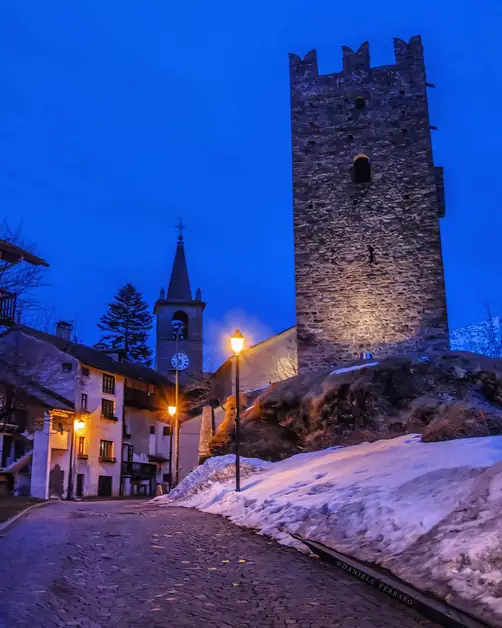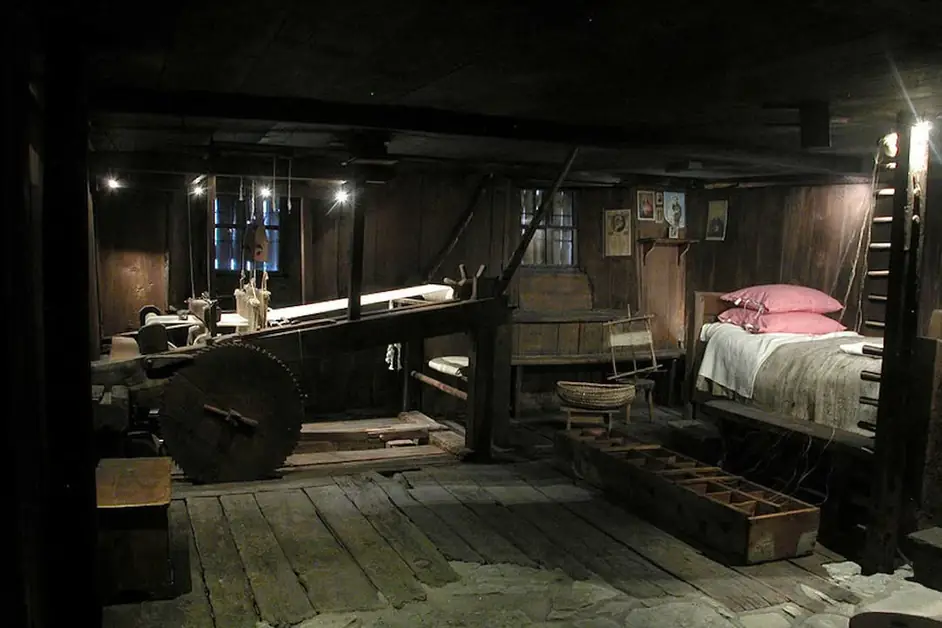The Medieval Tower of Champorcher and Its History
Discover the history and significance of the Medieval Tower of Champorcher.

Where is the Medieval Tower of Champorcher located?
The Medieval Tower of Champorcher is located in the heart of the capital of the Aosta Valley municipality, in a place known as Château, which in French means "castle". It stands on a small hill that dominates the village and represents what remains of the ancient castle of the Lords of Bard, built presumably in the 11th century. It is one of the most important historical and architectural symbols of the valley, currently visitable from the outside with a simple walk through the village.
How tall is the Medieval Tower of Champorcher?
The tower has a square plan with sides of about 6.40 meters and an overall height of 15 meters. Its harmonious proportions and severe appearance make it easily recognizable even from afar. It is built with local stone blocks, worked in a simple yet solid manner, typical of medieval fortifications in the Alpine arc.
How is the Tower of Champorcher structured?
The tower is a classic example of medieval defensive architecture. It features a swallow-tailed battlement, a symbol of power and authority, and an elevated entrance door located about 4 meters above the ground. This particular position served defensive purposes: access was through a removable ladder, which could be retracted in case of danger. Inside, the tower was divided into multiple floors with wooden lofts, connected by internal stairs. The narrow loopholes allowed light in and defense with bows or crossbows.
What function did the Medieval Tower have during the Middle Ages?
During the Middle Ages, the tower did not have a residential function but was defensive and used for lookout purposes. It was part of a signaling system that connected various towers and castles in the valley, including those of the Lords of Bard. From its elevated position, it was possible to monitor the valley and signal potential dangers with fires or smoke. Therefore, the tower represented a strategic observation and communication point between villages.
Who were the Lords of Bard and why did they build the tower?
The Lords of Bard were a powerful feudal family that controlled a vast territory between the Aosta Valley and Canavese. The tower of Champorcher was part of their fortifications and served to consolidate military and administrative control over the area. The construction likely dates back to the 11th century, a period when isolated towers were symbols of dominance and territorial defense.
Has the tower been restored over time?
Yes, the tower underwent several interventions over the centuries. It was rebuilt and restored in the 14th century by the Savoy, who maintained it as a strategic reference point. In the following centuries, with the end of feudal wars and the decline of military functions, the tower lost its defensive importance and fell partially into disuse. However, thanks to some modern restorations, it is now in good condition and continues to be one of the historical symbols of Champorcher.
Is it possible to visit the interior of the Medieval Tower of Champorcher?
Currently, the tower is not open for interior visits, but it is easily accessible from the outside. It is located in the historic center of the village and can be admired during a cultural walk through the ancient streets of Château. Even without being able to enter, the visit is very suggestive thanks to the natural context and the charm of the stone architecture.
What can be seen around the tower?
The village of Champorcher-Château still retains an authentic appearance today, with stone houses, slate roofs, and narrow alleys that tell centuries of Alpine history. From the tower, one can continue towards the parish church of San Nicola, another historically significant building. Additionally, just outside the village, there are various hiking trails leading to the hamlets of Chardonney and Dondena, thus connecting history and nature in a single itinerary.
Why is the Tower of Champorcher important for Aosta Valley history?
The tower represents one of the few remaining testimonies of medieval fortifications in the Aosta Valley. Besides its architectural value, it also has great symbolic significance, as it tells the era of small fiefs, alliances, and power struggles among noble families. It is a reference point for understanding the historical and territorial evolution of the valley.
What makes the visit to the Medieval Tower fascinating?
Visiting the tower means immersing oneself in an atmosphere of bygone times. The panoramic position, robust architecture, and remains of the surrounding medieval village offer an authentic glimpse into the Alpine past. Even without being able to enter, the tower conveys a sense of mystery and history, amplified by the silence of the mountains.
Is it easy to reach the Medieval Tower of Champorcher?
Yes, the tower is located just a few minutes' walk from the center of the village of Champorcher. It can be easily reached with a walk through the village, which also allows discovering other historical testimonies of the place. Those arriving by car can park in areas near the municipality or in public parking lots and then continue on foot.
When is the best time to visit the tower?
The tower can be visited at any time of the year. In summer and autumn, clear days allow for enjoying splendid views of the surrounding mountains, while in winter, covered in snow, the tower takes on a particular and fairy-tale charm. It is also an excellent starting point for discovering other historical and natural sites in the valley.
Are guided tours or cultural events organized in Champorcher?
During the summer season, the municipality of Champorcher often organizes guided walks and thematic itineraries that include visits to the tower and other monuments of the village. These initiatives allow for deepening the medieval history of the area and discovering curiosities related to noble families and ancient communication routes between the valleys.
Why is the Medieval Tower of Champorcher considered a symbol of the village?
Over time, the tower has become the identity symbol of Champorcher. It represents the continuity between the past and the present, between historical memory and today's life. Its silhouette dominates the landscape and recalls the medieval origins of the village, preserving centuries of history in just a few meters of stone.
What to recommend to tourists visiting the tower?
Those visiting the Medieval Tower can complete their excursion by exploring the historic center of Champorcher, visiting the church of San Nicola, and continuing along the natural paths leading to the Mont Avic Natural Park or Lake Miserin. It is a perfect itinerary to combine culture, history, and nature in a single day in the beautiful setting of the Aosta Valley Alps.

